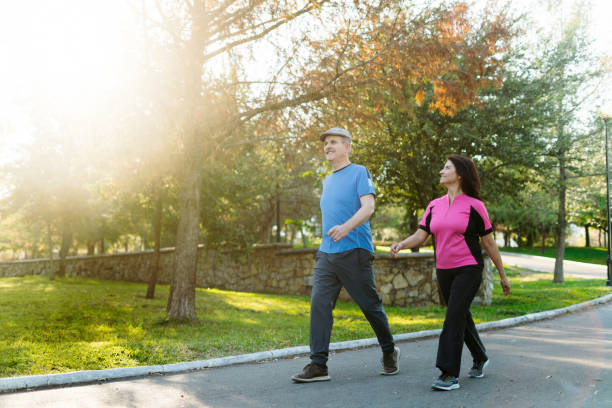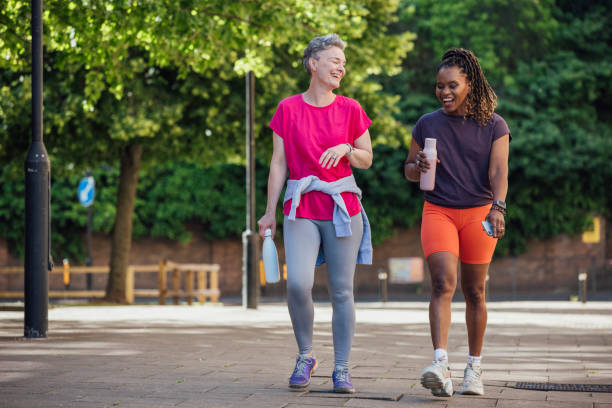Managing blood sugar doesn’t always mean spending money on costly treatments or following strict diets. One of the easiest and most effective ways to keep your blood sugar under control is by walking every day. This simple habit can lead to big improvements in your overall health.
In this article, we’ll explore how walking helps manage blood sugar, why it works so well, and how you can start adding it to your daily routine today for better health.
Why Blood Sugar Control Matters
Blood sugar, or glucose, is the main source of energy for your body’s cells. Your body needs the right balance to work properly. When blood sugar levels get too high or too low, it can cause health issues like fatigue, dizziness, or long-term damage to your organs.
Having high blood sugar (hyperglycemia) for a long time can slowly harm your body. Over time, it can damage your:
- Heart
- Kidneys
- Eyes
- Nerves
According to the Centers for Disease Control and Prevention (CDC), keeping your blood sugar within a healthy range can help prevent or delay serious problems linked to type 2 diabetes. Staying in control lowers your risk of nerve damage, heart disease, and kidney issues.
The good news? You don’t need a gym membership or expensive gear to get started. Walking every day is a simple and natural way to help stabilize your blood sugar and boost your overall health.

The Science Behind Walking and Blood Sugar
Walking is a moderate aerobic exercise that works large muscle groups in a steady, repeated motion. When you walk:
- Your muscles use glucose for energy
- Your body becomes more sensitive to insulin
- You burn calories, which can help with weight loss
According to Harvard Medical School, taking a short 15-minute walk after each meal can lower your blood sugar better than walking for 45 minutes once a day. These shorter walks help your body use glucose more quickly and keep levels steady.
Benefits of Walking for Blood Sugar Control
1. Improves Insulin Sensitivity
Walking helps your body use insulin in a better way. This means your cells absorb sugar more easily, so your blood sugar doesn’t spike as much after you eat.
Why it matters: When your body has better insulin sensitivity, it can use blood sugar more effectively. This means a lower risk of developing type 2 diabetes.
2. Reduces Blood Sugar Spikes
Walking after a meal helps your body clear glucose from your bloodstream more quickly. This simple habit can lead to better blood sugar control over time.
Try this:
Try taking a 10–20 minute walk about 30 minutes after you eat. This is the time when your blood sugar levels are most likely to peak. Walking then can help bring them down more quickly.
3. Helps With Weight Management
Too much body fat, especially around your belly, can make it harder for your body to use insulin. This is called insulin resistance. Walking helps burn calories and can lower belly fat over time, making it easier to manage blood sugar.
Bonus: Walking also supports a healthy heart, which is especially important for people with diabetes or prediabetes. It helps lower the risk of heart disease, a common concern with high blood sugar.
4. Supports Mental Health
Stress can cause your blood sugar levels to go up. Walking is a natural way to relax. It helps your body release endorphins, which can boost your mood and lower feelings of stress and anxiety.
“Physical activity is one of the best ways to reduce stress and improve your overall mental well-being.”
— American Diabetes Association
5. Promotes Better Sleep
Not getting enough sleep can make it harder to control your blood sugar. Walking regularly can help you sleep better at night. Taking a walk outside during the day also gives you natural light, which can improve your sleep cycle.
How Much Walking Do You Need?
You don’t need to run marathons to stay healthy. The most important thing is to be consistent. Walking a little each day adds up over time.
General guideline:
- Aim for 30 minutes of walking a day, at least 5 days a week
- Break it up if needed: 10 minutes after each meal works great
Even light walking makes a difference! If you’re just getting started, remember that every step counts and helps you move toward better blood sugar control.
Best Times to Walk for Blood Sugar Control
The timing of your walk can make a big difference in managing blood sugar. Here’s the best time to walk for the most benefits:
After Meals
- Helps reduce blood sugar spikes
- Especially helpful after carbohydrate-rich meals
In the Morning
- Kickstarts metabolism
- Sets the tone for an active day
In the Evening
- A gentle walk can improve digestion and support better sleep
You can adjust your walking routine to fit your daily schedule. What matters most is staying consistent and making walking a regular habit.

Tips to Make Walking a Daily Habit
Starting a new habit is easier when you use simple, smart strategies. The right plan can help you stay on track and make walking part of your daily routine.
Start Small
- Begin with 10-minute walks
- Add 5 minutes each week
Make It Enjoyable
- Listen to music or a podcast
- Walk with a friend or pet
Track Your Steps
- Use a pedometer or smartphone app
- Set daily goals (e.g., 7,000–10,000 steps)
Set Reminders
- Walk during lunch breaks
- Set calendar notifications
Dress Comfortably
- Choose good walking shoes
- Wear breathable clothes
Taking small steps each day can lead to big changes in your health—literally. A simple walk can have a lasting impact over time.
Walking Safety Tips for Beginners
- Be sure to check with your doctor before starting a new routine, especially if you have any health concerns or medical conditions.
- Stay hydrated while you walk—bring a water bottle to sip along the way and help your body stay cool and refreshed.
- Be easy to see—wear bright or reflective clothing if you’re walking in the early morning, evening, or low light. This helps keep you safe.
- Warm up and cool down—start your walk at a slow pace and end the same way. This helps prepare your body at the beginning and lets it relax at the end.
Common Questions About Walking and Blood Sugar
Does walking help lower A1C levels?
Yes! Walking on a regular basis can help lower your A1C, which measures your average blood sugar over the past 3 months. The results are even better when you pair walking with healthy eating habits.
How fast should I walk to get benefits?
Walking at a brisk pace is best, but even a slow, easy walk is good for your health. Try to walk at a speed where you can talk comfortably but wouldn’t be able to sing.
What if I miss a day?
That’s okay! If you miss a day, just pick it up again tomorrow. What matters most is making progress—not being perfect.
What Experts Say
“Even short walks after meals can significantly lower blood sugar levels.”
— Dr. Loretta DiPietro, George Washington University, via New York Times
“Regular exercise improves blood glucose control and reduces cardiovascular risk.”
— American College of Sports Medicine (source)
Easy Ways to Walk More Each Day
- Park a little farther from entrances to add more steps to your day. It’s an easy way to fit in extra walking without changing your routine.
- Choose the stairs instead of the elevator whenever you can. It’s a simple way to get your heart rate up and add more movement to your day.
- Walk while you talk—use phone calls as a chance to move around. It’s an easy way to add steps without needing extra time.
- Plan “walk and talk” meetings instead of sitting at a desk. It’s a great way to stay active while getting work done.
- Take a short walk after dinner. It’s a simple way to help your body digest food and keep your blood sugar steady.

Healthy Habits Work Best Together
Walking is a powerful tool for your health. It becomes even more effective when you combine it with:
- Balanced meals (whole grains, lean protein, fiber)
- Regular sleep (7–8 hours per night)
- Stress reduction (deep breathing, hobbies, meditation)
These healthy habits work together to build a strong foundation for better blood sugar control and improved overall wellness.
Ready to Take the First Step?
Walking is a free, easy, and effective way to boost your health. You don’t need special skills or fancy equipment to get started. Whether you’re managing diabetes, prediabetes, or simply want to stay healthy—making walking a daily habit is a smart choice.
Take Action Today:
- Lace up your shoes
- Start with a 10-minute walk
- Build from there
Your future self will thank you.
Let’s Hear From You!
Do you make walking part of your daily routine? Have you seen changes in your energy levels, blood sugar, or mood since you started?
Share your walking experience in the comments below! Let’s encourage each other to keep moving forward—both step by step and in our health goals.
And if you found this helpful, share it with a friend or loved one.

